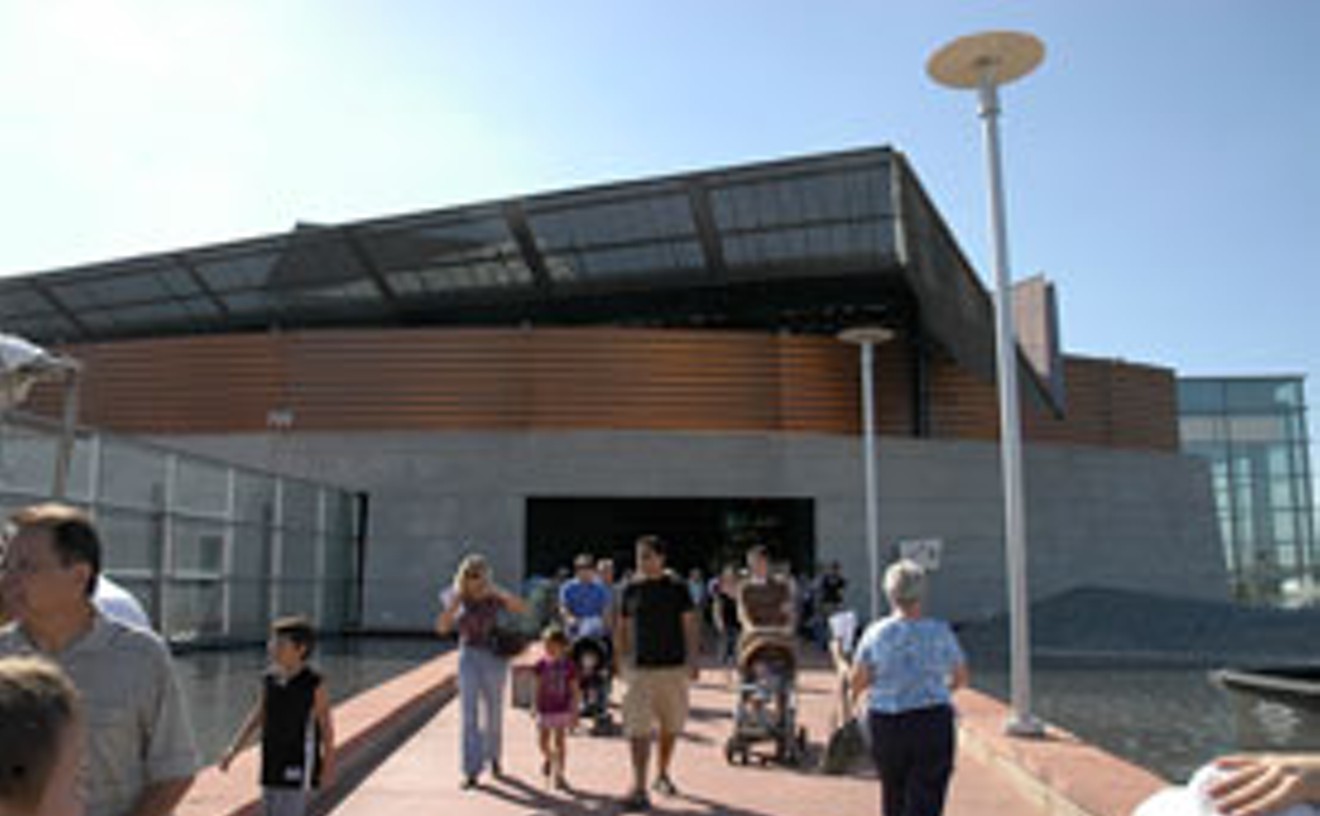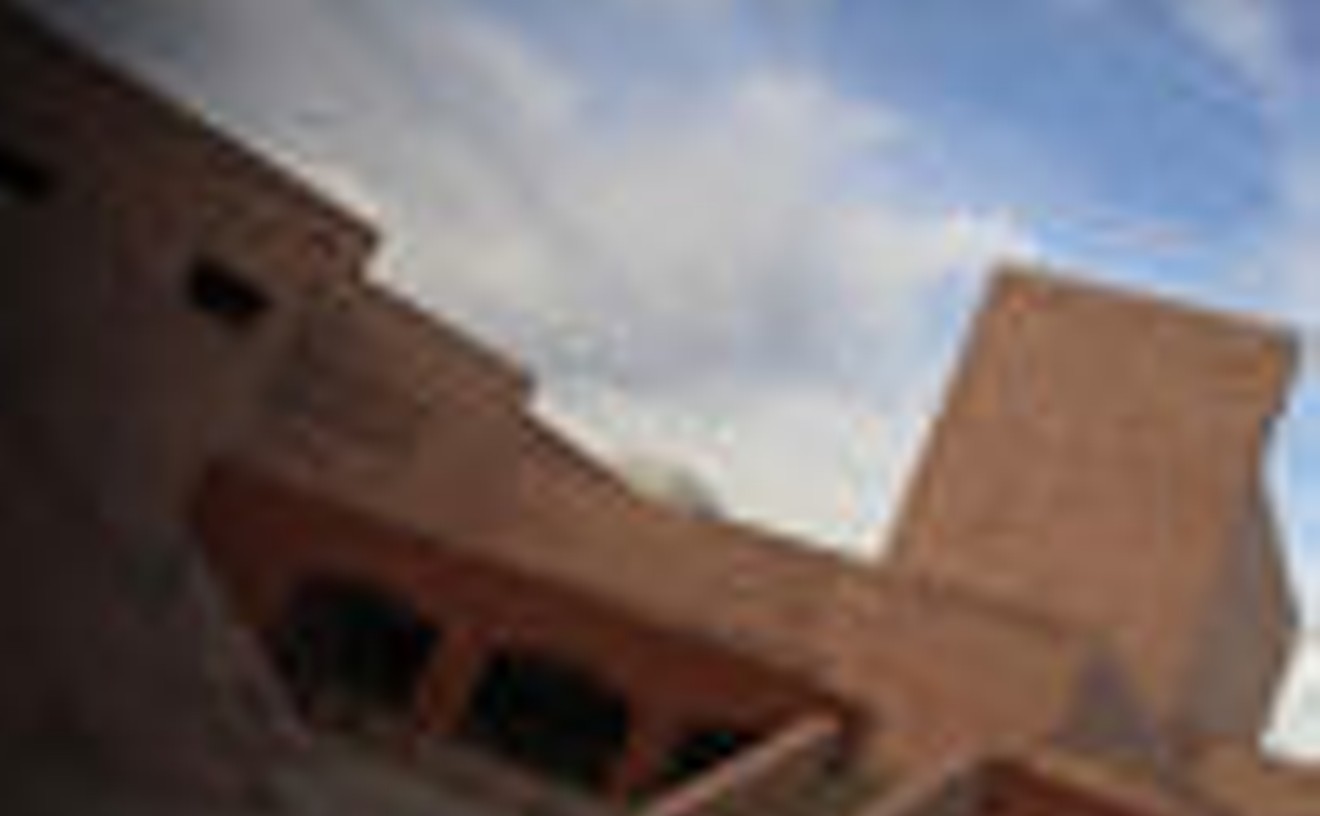A couple of years back, ASU Art Museum exhibited the politically charged works of LA artist Eduardo Sarabia in a show titled "Moctezuma's Revenge." Delving into and sometimes turning on its head Mexican culture, Sarabia skewered narco machismo with an eye toward history — and style. Carved from Mexican canterra stone and reaching seven feet in height, Sarabia's Snake Skin Boots with Snake Head still stands tall outside the Tempe museum, embellished with smiling snake heads and a nod to the Aztec god of war. It's a heavy statement, both literally and figuratively, as the sculpture piece weighs in at an immobile 4,000 pounds.
Best Border-Inspired Art Pioneer
Annie Lopez
It's impressive enough that Phoenix artist Annie Lopez is a fourth-generation Arizonan. But she's also a prolific art pioneer who first entered the local art scene in 1982, where she was part of a dynamic artist collective called MARS (Movimento Artístico del Río Salado). MARS Artspace, which operated in various Phoenix locations through the years, brought visibility to works by Chicano, Hispanic, and Native American artists. Today she's a nationally renowned cyanotype artist whose photographs, sometimes created on tamale wrapping paper and sewn into dresses, tell stories of her own experiences and those of her family. Many reference her Mexican roots — sometimes exploring the cultural stereotypes prevalent in contemporary society. Long before the border became a political topic du jour, Lopez was using her art to prompt reflection on the ways borders affect people's perspectives and actions — paving the way for more artists to incorporate themes of social justice into their art practice.
Best Border-Inspired Muralist
Lalo Cota
Day of the Dead festivals, inspired by the Mexican holiday Dia de los Muertos, pop up around metro Phoenix every fall. Add in Cinco de Mayo, and you've got a whopping couple of days when Mexican culture seems to be on everyone's mind. Works by Phoenix artist Lalo Cota, who was born in Navojoa, Sonora, Mexico, pretty much assure that those who see them will have Mexico on the brain a lot more often. You can't drive far in downtown Phoenix without seeing a mural he's painted alone or with one of his many collaborators. Many feature skulls or other iconic Day of the Dead imagery, or cars that embody Chicano lowrider culture. He's got mural art inside the new Barrio Café Gran Reserva and outside Carly's Bistro — plus dozens of other places. Seeing walls painted with Cota's signature skull-faced characters reminds people of Phoenix's relative proximity to the border — and the fact that being close to Mexico is a good thing, worthy of celebrating with more than just a few days of partying.
Best Border-Inspired Family Event
El Puente Theatre Festival and Mask Procession

Hundreds of families, nearly half of them Latino, converge on Tempe Center for the Arts when Childsplay and Cultural Coalition partner to present their El Puente Theatre Festival and Mask Procession. It's an annual festival-style event featuring free performances, art activities, and storytelling infused with Mexican culture that helps family members of all ages appreciate the value of diversity and learning about others' cultural heritage. There's mariachi music, folklorico dance, and even an exuberant parade, complete with musical instruments and giant puppets, across the Tempe Town Lake Bridge. Together, families from all different backgrounds experience the joy of celebrating Mexican culture together.
- 700 W. Rio Salado Parkway, Tempe, 85281 Map
- 480-350-2822
- tempecenterforthearts.com/
Best Latina Art Collective
Phoenix Fridas
It's been more than a decade since Kathy Cano-Murillo, an artist and author who's built her own brand as the Crafty Chica, started the Phoenix Fridas art collective. The roster of artists — all Latina artists inspired by renowned Mexican artist Frida Kahlo — has changed through the years. Even so, it's remained a fierce group united by mutual respect and creativity despite varying art styles, ages, viewpoints, and personalities. Nowadays, it has nine members who exemplify the entrepreneurial spirit while supporting each other's artistic expression. And, of course, the group shares the Frida and crafting love through exhibits, craft boutiques, workshops, and its annual community celebration of Frida Kahlo's birthday each July.
Best Border-Related Gallery Exhibition
"El Sueno Americano — The American Dream"

Photographer Tom Kiefer spent more than a decade working part time as a janitor for a U.S. Border Patrol facility near Ajo, Arizona, where he used his camera to document the personal effects seized from migrants, then thrown away — including wallets, underwear, rosaries, soap, birth control pills, and more. He grouped objects by type before photographing them, then turned his photos into an exhibition meant to prompt reflection on the dehumanization at the heart of turning such personal objects into trash. Through this powerful body of work, Kiefer highlighted commonalities shared by people across cultures and reminded viewers that border-related policies have significant implications for real people.
- 207 N. Gilbert Rd., Gilbert, 85234 Map
- 480-361-1118
- www.artintersection.com
Best Border-Inspired Performance Series
Arizona State University's Performance in the Borderlands
Amid popular culture saturated with the noise of nonsensical political rhetoric, ASU's Performance in the Borderlands fostered collaborations that created safe, yet challenging spaces for dialogue about some of the most pressing issues in contemporary American life — including immigration and racism. Working with Nia Witherspoon, it presented a lineup that included performances of Suzan-Lori Parks' America Play, which explores parallels between a young black man and President Abraham Lincoln. During an artist residency featuring Ana Teresa Fernández, whose work includes symbolically erasing parts of the U.S. and Mexico border by painting them blue to match the sky, it inspired reflections on ways to embrace rather than eschew people from diverse cultures.
Best Border Installation
Ana Teresa Fernandez
While others talk of building walls, San Francisco artist Ana Teresa Fernández is working to erase them. She's done several installations combining visual with performance art at various points along the U.S.-Mexico border. Most recently, she coordinated painting at three different sites, using live streaming video to assure that those who couldn't make the trek to the border would still feel a part of the process. Each time, Fernández buys blue paint matching the particular sky overhead, then invites others to join her in painting blue the prison-like bars comprising the border fence. From a distance, it seems the border has been erased, giving rise to new perspectives on what might be possible without its looming presence.
Best Curator of Border-Inspired Art
Julio Cesar Morales

When he joined ASU Art Museum as a curator in 2012, Julio César Morales said he was "particularly interested in art's unique ability to engage in a social context." It's something he's brought to life again and again, most recently with the exhibitions "Contemporary Photography in Mexico: Existe lo que tiene nombre" and "Miguel Angel Ríos: Landlocked." The latter, which included new videos commissioned by ASU Art Museum, was the first survey of video work by Ríos, who is based in Mexico City. Both were part of the museum's ongoing "Contact Zone" exhibition series, which explores contemporary migration and "its intricate uncertainties within border culture, destiny and contested histories." As curator for ASU Art Museum, Morales raises awareness of the many ways diversity fosters individual dignity and community strength, thus highlighting the value of cross-cultural experiences and dialogue.
- 51 E. 10th St., Tempe, 85281 Map
- 480-965-2787
- asuartmuseum.org/
Best DREAMer
Erika Andiola
She most certainly isn't the only one, but Erika Andiola is this year's best DREAMer. Andiola has been a prominent Arizona activist for undocumented immigrants for years. In fact, she has been called "the most well-known immigration activist in the country," and was hired by Bernie Sanders' campaign as a Latino outreach strategist late last year. Sanders may have conceded the presidential nomination to Clinton, but Andiola is demonstrating that la lucha sigue (the fight continues). She is now working with the post-election group inspired by Sanders' campaign, Our Revolution. The undocumented Mexican immigrant is renowned for confronting the likes of Russell Pearce and even President Barack Obama. She has earned the respect and admiration of immigration advocacy groups around the nation, and has been an inspiration for other undocumented immigrants living in the shadows.





